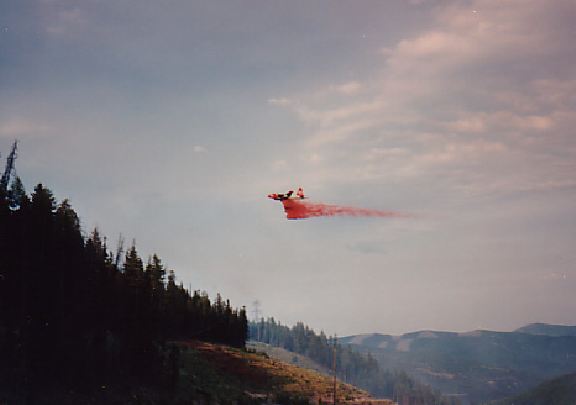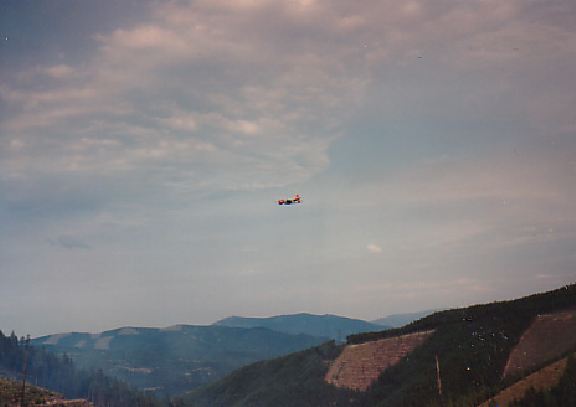BuzzH
Well-known member
cjcj, since you asked Rockydog about fires in clearcuts and how they can burn more...I'll take a stab at it.
Really this does depend on the type of clearcut and whether or not its been broadcast burned or not. That said, most cutting units are not burned for at least a couple years to allow the slash to dry so a broadcast burn can be effective on reducing the fuel load. Of course some units arent burned for several years, for all kinds of reasons...mostly air quality and burn window issues.
This is a photo I took while I was fighting a fire in 1994 in Montana, near the end of August. This fire started by lightning, on the edge of a clearcut and when we arrived was about 2-3 acres. By the time we'd walked down to the fire, about 1/4 mile, it had quickly grown to about 10-12 acres with flame lengths 40-50 feet. I determined it was burning too intensly for hand crews, pulled my crew to the road, and ordered a few loads of mud to cool the bastard down a bit. If I remember right, we got 6 loads of mud on the thing before we could begin hand line. In that time frame of about an hour the fire had ripped through the 50 acre clearcut and slopped over the upper road into the timber. Once the fire hit the timber, it layed down and moved one hell of a lot slower through the understory and never did reach the crowns. The flame lengths were 2-5 feet in the understory of the timbered part. The reason for this was because of the fuel loading in the clearcut, combined with the fact that everything is exposed to the sun, drying the fuels more and faster in the clearcut. The fire in the timber simply crept through the understory as there wasnt hardly any available fuel and I'd guess fuel moisture content was a bit higher.
Now I know theres a jillion different scenerios, but its a goddamned falicy that fires wont burn through clearcuts, and in some cases, like the one mentioned above, they actually burn more intensly in them.

Another shot of the same plane coming in.

Really this does depend on the type of clearcut and whether or not its been broadcast burned or not. That said, most cutting units are not burned for at least a couple years to allow the slash to dry so a broadcast burn can be effective on reducing the fuel load. Of course some units arent burned for several years, for all kinds of reasons...mostly air quality and burn window issues.
This is a photo I took while I was fighting a fire in 1994 in Montana, near the end of August. This fire started by lightning, on the edge of a clearcut and when we arrived was about 2-3 acres. By the time we'd walked down to the fire, about 1/4 mile, it had quickly grown to about 10-12 acres with flame lengths 40-50 feet. I determined it was burning too intensly for hand crews, pulled my crew to the road, and ordered a few loads of mud to cool the bastard down a bit. If I remember right, we got 6 loads of mud on the thing before we could begin hand line. In that time frame of about an hour the fire had ripped through the 50 acre clearcut and slopped over the upper road into the timber. Once the fire hit the timber, it layed down and moved one hell of a lot slower through the understory and never did reach the crowns. The flame lengths were 2-5 feet in the understory of the timbered part. The reason for this was because of the fuel loading in the clearcut, combined with the fact that everything is exposed to the sun, drying the fuels more and faster in the clearcut. The fire in the timber simply crept through the understory as there wasnt hardly any available fuel and I'd guess fuel moisture content was a bit higher.
Now I know theres a jillion different scenerios, but its a goddamned falicy that fires wont burn through clearcuts, and in some cases, like the one mentioned above, they actually burn more intensly in them.
Another shot of the same plane coming in.




